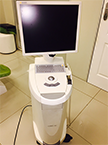
Basic dental care involves brushing and flossing your teeth regularly, seeing your dentist and/or dental hygienist for regular checkups and cleanings, and eating a mouth-healthy diet, which means foods high in whole grains, vegetables and fruits, and dairy products.
Keeping your teeth and gums healthy requires good nutrition and regular brushing and flossing.
- We complete a “risk factors” form that tells us the patient’s risk for developing certain diseases, such as periodontal disease and oral cancer.
- After that, we perform what we call a head and neck exam. We feel the neck to note any enlarged lymph nodes or any suspicious lumps or bumps that could be cancerous.
- Next, we move on to the intraoral soft tissue exam. The soft tissue exam consists of looking at every area in your mouth. We look at the lips, the cheeks, the gums, roof of the mouth, every side of the tongue, under the tongue, in the back of the mouth, the throat and the tonsil area. Your tonsils can tell us if your body is fighting off a disease.
- Another part of the dental exam is periodontal probing. This consists of sticking a little instrument between your teeth and your gums to see how healthy your gums are. We measure the space between the top of the gums and where your gums attach to your teeth. If it’s too deep, you won’t be able to clean it out well and it could indicate that you have periodontal disease, which is a leading cause of tooth loss in people over age 30
- Next we perform a hard tissue (teeth) exam where we look at every side of your teeth and note any existing fillings, crowns, implants, root canals, cavities, fractures, or if there are any problems with your bite. We also look at all of your dental work to make sure that it is still in good shape. Depending on the health of your teeth, we may order x-rays to better diagnose any problems with the teeth and the area around the tooth.
- After gathering all of the above information, we create a treatment plan with all of the dental work that we recommend having done. Sometimes this is as simple as getting a regular cleaning and providing instructions on how to maintain better oral hygiene or it can be as complex as getting dentures, crowns, bridges, root canals, implants, veneers, braces, and other dental treatment.
With the CEREC technology, it is now possible to reduce the amount of follow-up work and time-intensive occlusion ... Read More...
The importance of your smile cannot be overstated – it’s the first thing that many people will notice about you... Read More...
A comprehensive dental examination consists of several parts read more..
A scale and polish cleans your teeth very thoroughly. Read More...
A dental restoration or dental filling is a dental restorative material used to restore the function, Read More...
It's not unusual for patients to be anxious, nervous, or even fearful of the dentist's chair. Read More...
A bridge is used as a permanent replacement for one or more missing teeth. Read More...
Teeth are stained by the foods and drinks we consume. Read More...
All our orthodontic treatments are done by our in house orthodontist. Read More...
If you have a few or all of your teeth missing, one solution is to have a denture. Read More...
Root canal treatment (also called Endodontics) is needed when the pulp inside your tooth becomes infected Read More...
The Wand as it is known, is essentially a computer-controlled dental injection... Read More...
Our practice can provide a wide range of dental services... Read More...
Digital radiography is a type of X-ray imaging that uses digital X-ray sensors to replace traditional photographic X-ray... Read More...
-
Phone:
-
Email:
angelam@polka.co.za














